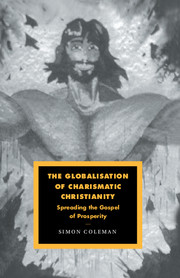Book contents
- Frontmatter
- Contents
- List of illustrations
- Acknowledgements
- Introduction
- Chapter One A ‘weird babel of tongues’: charisma in the modern world
- Chapter Two ‘Faith which conquers the world’: globalisation and charisma
- Chapter Three Sweden: national ‘state’ and global ‘site’
- Chapter Four The Word of Life: organising global culture
- Chapter Five Words: from narrative to embodiment
- Chapter Six Aesthetics: from iconography to architecture
- Chapter Seven Broadcasting the faith
- Chapter Eight Expansive agency
- Chapter Nine Contesting the nation
- Chapter Ten The Word and the world
- References
- Index
Chapter Six - Aesthetics: from iconography to architecture
Published online by Cambridge University Press: 22 September 2009
- Frontmatter
- Contents
- List of illustrations
- Acknowledgements
- Introduction
- Chapter One A ‘weird babel of tongues’: charisma in the modern world
- Chapter Two ‘Faith which conquers the world’: globalisation and charisma
- Chapter Three Sweden: national ‘state’ and global ‘site’
- Chapter Four The Word of Life: organising global culture
- Chapter Five Words: from narrative to embodiment
- Chapter Six Aesthetics: from iconography to architecture
- Chapter Seven Broadcasting the faith
- Chapter Eight Expansive agency
- Chapter Nine Contesting the nation
- Chapter Ten The Word and the world
- References
- Index
Summary
Social scientists as well as theologians tend to describe evangelicalism as a religion of the word in opposition to the object or image. Harding (1987:169) emphasises how Baptist services and revivals are stripped of imagistic and sacramental material as a means of intensifying and focussing religious rhetoric. Goethals (1985:151) refers to the way the expressive power of architectural settings and material artefacts is minimised in evangelical contexts, in deference to the persuasive functions of words. Rosman (1984:159), finally, describes the evangelical tendency to depreciate human artefacts, on the grounds that physical forms cannot compete with the Word of God. These examples imply that evangelicals provide a contemporary version of the iconoclasm of original Protestant reformers who abhorred the base circumscription of the sacred on the grounds that it contaminated divine prerogative (Freedberg 1989:62). The emphasis on the inspired Word seemed to privilege direct communication with God over the mediations of a corruptible Church. Thus, Eire (1986:315) describes the aesthetic consequences of the post-Reformation concern that finitum non est capax infiniti – an unbounded God could not be confined to mundane objects and images: ‘The stripped, whitewashed church in which the pulpit replaced the altar became the focal point of a cultural shift from visual image to language.’
In some respects, Word of Life ideology and practice appear to echo such scholarly descriptions of radical Protestantism. The members of the Swedish group commonly define themselves precisely through their attempts to achieve unmediated and inspired access to the divine.
- Type
- Chapter
- Information
- The Globalisation of Charismatic Christianity , pp. 143 - 165Publisher: Cambridge University PressPrint publication year: 2000



